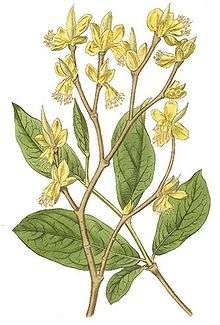Dirca
| Dirca | |
|---|---|
 | |
| Dirca palustris | |
| Scientific classification | |
| Kingdom: | Plantae |
| (unranked): | Angiosperms |
| (unranked): | Eudicots |
| (unranked): | Rosids |
| Order: | Malvales |
| Family: | Thymelaeaceae |
| Genus: | Dirca L. |
| Species | |
| |
Dirca (Leatherwood) is a genus of three or four species of flowering plants in the family Thymelaeaceae, native to North America. The genus is named after Dirce in Greek mythology. The general common name for this deciduous shrub is leatherwood; other names include moosewood, ropebark and Powhatan-derived wicopy. The stems of Dirca are exceptionally pliable and the bark is difficult to tear by hand; for this reason, its stems were used by Native Americans in eastern North America as thongs or ropes. Members of the genus can grow to a maximum height of about three meters, and are often associated with rich, moist woods or slopes above creeks or streams.
D. palustris is a widespread species that grows in scattered populations throughout eastern North America, from Nova Scotia west to North Dakota and Oklahoma, and south to Florida. D. occidentalis grows in several counties in the San Francisco Bay area of California. D. mexicana was described in 1995 from one population in northeastern Mexico. In 2008, a fourth species, D. decipiens, was described from several populations in Kansas and Arkansas, at the southwestern limits of the range of D. palustris.
Dirca palustris is occasionally cultivated, although its slow growth seems to prevent its widespread use in horticulture. The shrub can be difficult to recognize because the flowers are small (less than one cm), displayed for only a short period in the early spring, and may be a nondescript greenish-yellow. In the central part of its range, D. palustris is often found growing with the much more frequent spicebush, which also has small yellow flowers that appear before the leaves at a similar time.
Although it is listed as poisonous in some publications because its stems and leaves contain calcium oxalate crystals, its toxicity is uncertain and may be low. Likewise, the berries may have narcotic properties, although this claim remains unsubstantiated.[1]
References
- ↑ Erichsen-Brown, C.Medicinal and Other Uses of North American Plants. 1989. pg 179.
External links
- Dirca at USDA Plants Database
- Jepson Flora Project: Dirca occidentalis
- Dirca palustris in North Carolina State Poisonous Plants Handbook
- Thoreau writes about Dirca